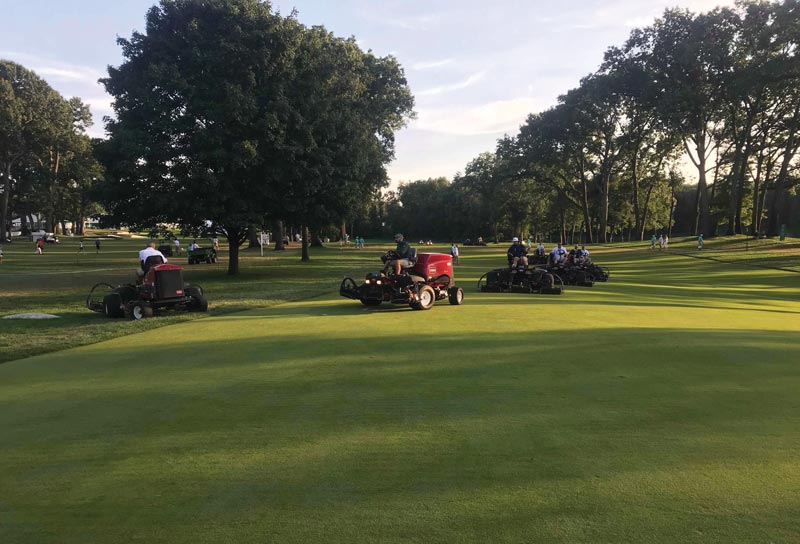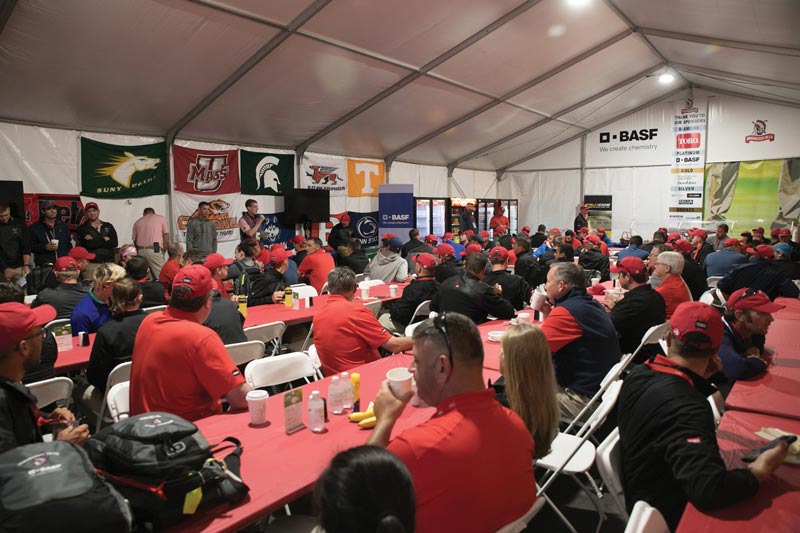
A parade of fairway mowers finishes up their last pass on the third hole at Ridgewood Country Club in Paramus, N.J., during the 2018 Northern Trust Championship. Photos courtesy of Andrew Baxter
Editor’s note: This article was originally published in the September/October 2018 issue of Tee to Green, a publication of the Metropolitan Golf Course Superintendents Association, Elmsford, N.Y.
There’s more to being a tournament volunteer than hard, slogging work. When you sign up to lend a hand at one of the many local or national tournaments, you’re opening the door to a world of skill-building and networking opportunities within the golf industry. What’s more, when you volunteer, you show not only your commitment to the industry, but also that you’re equipped to work in the high-level, high-stress situations typical of the superintendent profession.
Here in the New York City metropolitan area, we have our share of large events, with clubs hosting everything from Mid-Amateurs to U.S. Opens. Yet turf managers have also been known to travel far and wide for the opportunity to work a major tournament at a top-ranked club.
So, is the payoff worth the time and effort? We spoke with both volunteers and superintendents who have hosted major events to get their take on how the benefits of tournament volunteering stack up against the sacrifices. Here, the inside scoop from tournament hosts and volunteers themselves.
What are tournament hosts looking for?
Having qualified volunteers during a tournament week eases the burden on host superintendents and their crews. While it’s a gift to have people volunteer their time and hard labor to make an event happen, it’s a sizable job to manage them. Everything from coordinating their varying duties to arranging for their lodging, food and attire is part of the host superintendent’s already lengthy to-do list.
Though quite a number of courses in the New York City metropolitan area host tournaments that depend on volunteer help, there’s no guarantee that those who apply for a volunteer slot will be selected. In fact, most tournament hosts screen potential candidates by having them fill out a short survey on what they can do with confidence during the week of the tournament. This is an easy and effective way for superintendents to make sure they have a pool of capable help on board.
Todd Raisch, CGCS, who hosted the 2018 Northern Trust Championship at Ridgewood Country Club in Paramus, N.J., confesses, however, that the competition for quality volunteers is so strong in the area that he doesn’t turn many away.
“While we like to have volunteers trained in a wide range of skills, we are happy to have anyone willing to work,” says Raisch, a 25-year GCSAA member. “We have jobs that even lesser-skilled volunteers can easily do — everything from raking bunkers and filling divots to checking to see that the turf around green surrounds isn’t matted down.”
Raisch is quick to note that having cross-trained volunteers pays dividends if there is perhaps a series of unfortunate events or the weather is working against you. “It is rare to get through the week without some sort of calamity,” Raisch says. “Not having to sort through qualifications when you’re in a pinch and need to find the right person to fix a damaged hole, operate a chain saw or just fill in for a no-show takes a lot of pressure off managing the week. And of course, having to rake 150,000 square feet of bunkers in 20 minutes, as we had to do after a downpour during the 2010 Barclays, is a lot easier with 105 people on staff than with our normal 35!”
Andrew Wilson, director of agronomy at Bethpage State Park in Farmingdale, N.Y., has been planning for the 2019 PGA Championship at the Black Course for quite a while. He is no stranger to hosting major events, with two U.S. Opens and a Barclays under his belt when he was an assistant and then superintendent at Bethpage. Wilson knows the advantages of recruiting volunteers with tournament experience, and also high on his list of priorities is gathering a diverse group of volunteers — everyone from superintendents, assistants and interns to vendors and university faculty.
“The diversity,” he explains, “gives us a full complement of skill sets while at the same time creating a great opportunity for camaraderie and networking among the volunteers during the week.”
Wilson, a 19-year GCSAA member, admits that hosting events at a facility such as Bethpage makes recruiting experienced volunteers much easier. “Many of our volunteers have worked at Bethpage in the past and return to lend a hand when a large event comes to the property,” he says. “That means they know where the holes, roads and access points are, and that type of familiarity also allows them to lead crews to get tasks completed much more efficiently.”
At Shinnecock Hills Golf Club in Southampton, N.Y., site of the 2018 U.S. Open, superintendent Jon Jennings, CGCS, had 400 applicants knocking on his door for the opportunity to volunteer at the club’s first Open since 2004. Two hundred volunteers made the cut.
“We had turf students, assistants and superintendents,” the 34-year GCSAA member says, noting that he gave preference to those who lived in the region and then expanded his recruiting efforts out from there. “I didn’t want people living in close proximity excluded. And besides, recruiting locally encouraged a sense of ownership and pride.”
Like Raisch and Wilson, Jennings was able to enlist volunteers with a range of experience. “We had our volunteers list their skills and then matched them with the appropriate tasks,” he says. “We wouldn’t have a superintendent walk-mowing greens, but we would assign supers to go out with people on greens mowers and oversee and assist in the work being done.”

Volunteers at the 2018 U.S. Open at Shinnecock Hills Golf Club in Southampton, N.Y., await their marching orders for the day.
With the abundance of volunteers at Shinnecock Hills, there was no shortage of networking opportunities. “We had more people than we ever needed, and without any inclement weather that required more hands on deck, we would often have several people working together,” Jennings says. “That, naturally, gave them the opportunity to chat and swap stories and experiences.”
Also boosting volunteers’ networking capabilities was a binder that listed each volunteer’s name and place of employment. “It’s handy to have everyone’s contact information readily available,” says Jennings, noting that the purpose of the binder was to make it easier for people to stay in touch after the tournament.
The tangible benefits of tournament volunteering
At Ridgewood Country Club, volunteers who work the full seven days of a tournament get the royal treatment. The club provides them with local hotel accommodations, allowing them to avoid a long trip home after an early-morning start or late-night end. All shifts begin with a start-of-shift meeting during which jobs are assigned and volunteers are filled in on the plan of action for their shift. Most morning shifts begin at 4 a.m. and finish up around 9 or 10 a.m. Evening shifts typically run from 4 p.m. to around 9 p.m. Schedules vary, of course, depending on the particular tournament schedule. Volunteers are encouraged to stay around and socialize and watch some good golf, or to head back to housing between shifts to recharge and get some shut-eye.
In addition to the gratis lodging, volunteers at Ridgewood are well fed. “Everyone is provided with plenty to eat and drink,” says Raisch. “And if you stay late enough, there might even be adult beverages provided.”
Raisch also supplies diversions for volunteers between shifts, including ping-pong, synthetic putting greens and even video games. And the volunteer common area is outfitted with leather sofas, air mattresses and individual lockers. “Those in the know bring a swimsuit with them and spend many an afternoon in the pool at our golf professional’s house, which is along the first hole,” Raisch adds.
Raisch attempts to make the volunteer experience at Ridgewood as rewarding as possible. “We go out of our way to improve our incentives each time we host an event,” he says. “For instance, we have a tiered system of ‘thank you’ giveaways. The more volunteers work, the more they receive.” The giveaways can range from tournament golf shirts to golf pullover jackets, and the gift selection gets more extensive with each tournament the club hosts.
One of Raisch’s favorite perks, though, is a rather new tradition that has begun at Ridgewood: A group of regular volunteers picks a different spot each night where they rehash the day over drinks.
“I love this part of the day,” Raisch says. “We end up in hospitality tents, scenic points on the course, in grandstands, somewhere new every night. Word spreads each night about where we’re going. Then, little by little, people begin to show up as they finish their jobs. It’s a lot of laughs and great camaraderie.”
Bethpage offers a number of perks similar to Ridgewood’s, one of which is putting volunteers up at the local university or a hotel. “From there, we outfit them pretty well with gear and provide plenty of food and drink,” says Wilson, who hopes to add another bonus for those who volunteer for this year’s PGA Championship: guest speakers.
“When I visited at Bellerive and Shinnecock in 2018 to observe their tournament operations, there were several times during the week that special guest speakers came to give the volunteers a quick talk, on everything from architecture and maintenance to a pep talk on team building,” Wilson says. “I really enjoyed that part of the week and would like to do the same for our volunteers.”
“We did have a speaker each evening of the tournament,” says Jennings of the 2018 U.S. Open at Shinnecock Hills. “The talks ranged from inspirational to educational and were just another perk of the volunteer experience. Everyone seemed to enjoy them.”
The intangible benefits of tournament volunteering
When you volunteer for one of these major tournaments, whether it’s for a few shifts or the entire week, you sign on for a crash course in tournament prep and maintenance, which often involves learning the art of skillfully pushing the turf to the brink of disaster — but never over!
This type of high-pressure environment puts everyone’s skills — both interpersonal and agronomic — to the test. But along with offering an unparalleled learning experience for any volunteer, volunteering provides assistant superintendents with a long list of other benefits, including the opportunity to network, experience another club’s operation, and quickly build their résumés.
Steve Brazer, an assistant superintendent at Winged Foot Golf Club in Mamaroneck, N.Y., has volunteered at eight events and says he enjoys the variety offered by each experience. “Every tournament involves something different — tasks, weather conditions, unexpected challenges,” Brazer says. “You realize how important it is to be flexible and ready to tackle anything and everything.”
For Brazer, working closely with a team of volunteers fosters a special camaraderie and a shared commitment to helping a fellow turf professional succeed before and during a tournament. “It’s a tightly knit industry, and we are all in it together, especially during crunch time as the tournament is being played,” the one-year GCSAA member says.
Anthony Minniti, assistant superintendent at The Creek Club in Locust Valley, N.Y., has lent his services at eight tournament events. Like Brazer, Minniti thinks one of the primary motivating factors for volunteering during a major tournament is the desire to help a fellow industry professional. Another is the opportunity to network.
“These events are great for connecting, face to face, with local vendors and a variety of industry professionals,” says Minniti, a 10-year GCSAA member. “You just never know when one of these contacts might provide an ‘in’ to a job you’re after.”
And while no tournament volunteer likely ignores the many tangible benefits derived from assisting with such an event — high-quality gear and clothing, nice accommodations, food and drink, the chance to be front and center for the tournament action — the long-term payoff is clearly more important. Your good deed provides something money can’t buy: the incomparable opportunity to swiftly elevate your skill set and add marquee courses to your résumé.
“When hiring, clubs are looking not only for the proper educational background, but also a history of diverse experiences,” says Shinnecock Hills’ Jon Jennings, who has volunteered for at least 25 tournament events, from PGA Tours to U.S. Opens and Amateurs. “Volunteering also shows employers the stuff you’re made of. Performing a variety of duties in a high-pressure environment speaks volumes about your work ethic and initiative.”
Jim Pavonetti, CGCS, superintendent at Fairview Country Club in Greenwich, Conn., volunteered at numerous events during his time as an assistant. He notes another, less obvious benefit assistants can derive from pitching in on an array of courses. “Volunteering at a variety of clubs can help you determine your personal career goals, particularly the type of operation you might like to manage one day,” Pavonetti says. “Some guys have their sights set on big operations like Winged Foot and Westchester. Others see quickly that managing a multiple-course facility will never be in their wheelhouse.”
Winged Foot assistant Steve Brazer discovered his career path when he was working as a crew member at a public course in Massachusetts and decided to volunteer for his first tournament, the Deutsche Bank Championship at TPC Boston. “Coincidently, I ended up raking bunkers alongside my old boss from a landscaping company, and he mentioned to me that golf course work could actually be a viable career option,” Brazer recalls. “That thought stuck with me. Later that year, I enrolled in the Rutgers two-year program with my sights set on working at a high-end course one day.”

The trophies for two upcoming tournaments at Bethpage State Park in Farmingdale, N.Y. The Wanamaker Trophy, left, will go to the 2019 PGA Championship winner, and the trophy on the right will go to the 2024 Ryder Cup victor.
Regardless of an assistant’s ultimate career goals, volunteering is a prime opportunity to work alongside and observe the strategies of top professionals in the field. This not only helps assistants refine their existing skills, but gives them added confidence in those abilities.
Anthony Minniti particularly values having the chance to pick the brains of fellow assistants and superintendents from other facilities during tournament events. “I listen to the issues they struggle with on their courses and how they’ve remedied them,” he says. “I also like to see firsthand other ways to complete specific tasks. It’s great to be able to take some of the best ideas I encounter and implement them on my home course.”
“Volunteering at a major tournament is not unlike an internship,” says Pavonetti. “It offers assistants the opportunity to not only gain further insight into the industry, but also learn about the latest industry trends, advances in equipment and/or technology, and what, exactly, helps a course stay ahead of the game.”
As you speak with tournament volunteers, you begin to realize there are almost as many reasons people choose to volunteer as there are tournaments. While Steve Brazer, for instance, finds tournament experience helpful in advancing his skills and career, one of his prime motives for volunteering now is to pick up tips and techniques he can apply when Winged Foot hosts the U.S. Open in June 2020.
“Working a variety of major events has given me different perspectives on what goes into hosting a tournament,” says Brazer. “Whether it was while working on the crew at TPC Sawgrass leading up to a major tournament or volunteering at numerous other venues, the knowledge I gained has been invaluable in planning for the U.S. Open.”
Superintendents tout the volunteer trail
Many successful superintendents in the New York City metropolitan area credit where they are today to working at tournaments.
Jim Pavonetti of Fairview Country Club looks back fondly on his volunteer experience at the 1997 PGA Tournament at Winged Foot with then-superintendent Bob Alonzi. “I remember helping one of Bob Alonzi’s mechanics set at least 25 walk mowers,” he says. “Back then, Winged Foot walk-mowed fairways for the PGA Championship. I had just finished working on the course for the evening, and as I was walking to my car to go home, I saw a lineup of mowers waiting to be set outside the shop and couldn’t resist stopping. Well, I was there until about 10:30 at night, helping to get those mowers ready for the next morning. It’s an experience I’ll never forget.”
Pavonetti, a 23-year GCSAA member, was also one of those who picked up a handy trick of the trade that he brought back to his home course, Willow Ridge Country Club, where he was an assistant at the time. “In one tournament, we raked bunkers with extra-long, homemade handles so that we could have one continuous rake stroke to make the bunkers look uniform and perfect,” he recalls. “We started doing that at my home course, and the members loved it.”
Shinnecock Hills’ Jon Jennings finds tournament experience so valuable that he recommends young professionals in the industry volunteer for at least one tournament per year. “It can seem a bit daunting to find a week to volunteer in the midst of a busy summer schedule,” Jennings says, “but it can also be a good change of pace.”
Ridgewood’s Todd Raisch also extols the advantages of a volunteer getaway. “It can be a fun diversion from the summer grind and a much-needed change of scenery, especially at the time of year when most of our events seem to be scheduled, mid- to late August,” Raisch says.
Of all the benefits surrounding tournament experience, the superintendents we spoke with touted networking as No. 1.
“A lot of new friendships and connections are developed during tournament week,” says Raisch.
“Your network is so important for future job opportunities and for advice and tips,” adds Pavonetti. “You can’t go wrong with meeting dozens of new turf managers, and there’s no better way to do that than volunteering at an event.”
Bethpage’s Andrew Wilson agrees. “The networking opportunity for young professionals volunteering at an event is exceptional,” he says. “To spend a week getting to know supers, assistants, vendors and university faculty is a great opportunity to learn from the best and create contacts from across the country.”
These contacts can develop into lasting friendships — or at least a familiar face at industry events. “I run into people at GIS who I met years ago as a tournament volunteer, and it’s always great to catch up,” Wilson says. “But more important,” he adds, “you never know when one of those contacts may prove useful in a job search one day. It is, after all, often who you know, not what you know, that matters when you’re looking to climb the career ladder.”
When all is said and done, volunteering is a win-win. The host superintendents benefit from the much-needed help, and the volunteers prosper from the one-of-a-kind opportunities to expand their skills, their network and their confidence as competent turf professionals.
If you have any interest in volunteering at a tournament this year, reach out to host superintendents and inquire about whether they are in need of any volunteers for their upcoming tournament. You can find lists of PGA and USGA tournaments on their websites. There’s little doubt they’d love the help.
A day in the life of a tournament volunteer
The day began at 4 a.m. I was one of more than 70 volunteers from all over the world who had gathered at the site of the 2018 Northern Trust Championship, Ridgewood Country Club in Paramus, N.J. We started by checking in for the morning shift. I was directed to a locker, which became mine for the duration of the tournament. There, I found a uniform and tournament gear that I was expected to wear throughout the week.
Once suited up and ready for action, the other volunteers and I waited for our morning assignments. Joining us were Ridgewood’s 35-plus regular grounds staff members. We were all eager to help prepare for this world-class event, which was the first stage of the FedEx Cup Playoffs.

Tiger Woods and his caddie, Joe LaCava, discuss Woods’ second shot into the 440-yard, par-4 fifth green during the 2018 Northern Trust Championship at Ridgewood Country Club. The green is elevated and protected by treacherous bunkers.
I was fortunate to be selected to work on the golf course for not only the week leading up to the championship, but also throughout the tournament. Like many other volunteers, I was assigned to work both the morning and evening shifts.
Between shifts, volunteers had the option of going back to the hotel to get some rest or hanging around the employee lounge, where they could play ping-pong and other games or just catch up with friends. My assignment afforded me free entry into the tournament, which I attended during my break between shifts. After a short rest at the hotel, I would head back to the course in time to watch some of the later groups come through. Many days, I would catch Dustin Johnson or Tiger Woods for a few holes before starting my evening shift.
It was pretty exciting to get an up-close view of some of the best golfers in the world — there were 125 of them — as they set out to advance to the next stage of the FedEx Cup Playoffs. It was also exciting to be near the 18th green to watch Bryson DeChambeau outplay everyone in this leg of the tournament, his first of back-to-back victories during the FedEx Cup Playoffs.
The assignment
While some volunteers were dispersed around the course and charged with raking bunkers and mowing tees and fairways, my morning assignment was to mow greens. My evening job consisted of mowing fairways with six other volunteers. Both assignments required a steady hand and laser focus, but then again, any of the prep work being done for the week required an eye for perfection.
The PGA, I quickly learned, is very particular about how a course is maintained as well as how it’s set up for the week of a tournament. Even the way the bunkers are raked is scrutinized. Fairway bunkers must be raked parallel to the fairway, while greenside bunkers are to be raked facing the green.
Just like all other aspects of maintenance, everything I did had to be checked and rechecked to ensure playing conditions were beyond perfect. This was the type of perfection that very few could detect; nonetheless, it was a top requirement of the job. There were actually people assigned to “quality control,” and their job was to follow behind the volunteers to make sure every task — from divot repair and bunker raking to green, tee, and fairway mowing — was executed flawlessly.
The payoff
In the end, the tournament prep went off without a hitch. Thanks to the help and guidance of the regular Ridgewood employees, all 70 of us volunteers were able to grasp the lay of land and our assigned roles. Sure, it took hard work and long hours, but with the tremendous team effort put forth, Ridgewood was more than ready, by the week’s end, for the 2018 Northern Trust Championship.

A volunteer team at the 2018 Northern Trust Championship at Ridgewood Country Club after mowing the 18th green for the last time. From left to right: Jeff Reggio from Baltusrol Golf Club in Springfield, N.J.; Leo Barber from Paraparaumu Beach Club in New Zealand; and Andrew Baxter from Fairview Country Club in in Greenwich, Conn.
For me, volunteering at this event was well worth the investment of time and effort. It gave me the opportunity to experience firsthand the enormous amount of planning and work that goes into hosting a major golf tournament. And in the process, I picked up a few new maintenance techniques and cultural practices that I was able to bring back to our operation at Fairview. But just as valuable was having the opportunity to work alongside a variety of people, who bring with them a variety of experiences and perspectives on golf course management.
I met assistants, superintendents and sales reps from across the U.S. and from Australia and the U.K. Working together so intensively toward a common goal created a bond that I feel enabled me to form more than a few lasting connections.
Though challenging, I can’t emphasize enough how fulfilling an experience volunteering at a tournament can be. And there is no doubt in my mind that this experience will aid me in my journey toward securing a head superintendent’s position one day.
There always seems to be occasions to volunteer here in the New York City metropolitan area. I urge anyone to pursue the opportunity to volunteer for at least one major event. I guarantee, you won’t regret it.
Andrew Baxter is an assistant superintendent at Fairview Country Club in Greenwich, Conn., and a three-year member of GCSAA.